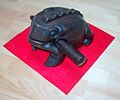Güiro
The Güiro or Guiro [pronounced guˈi: ʁo ] ( Spanish , "bottle gourd", "ratchet cucumber" or "fish", "cucumber") is an approximately 30 to 40 cm long, hollow shrap vessel with an elongated slit with notches on the Top side that is rubbed with a stick. Common in some musical styles in Central America , the Güiro is used as a rhythm instrument and percussion instrument.
Layout and function
Originally, the Güiro was made from a hollowed-out calabash . Today it is usually made of wood , in a modern version it is also made of fiberglass . A similar shape is made of metal and is also called "torpedo" because of its shape.
The güiro is played with a 12 to 15 cm long, conically cut wooden stick, but also with a porcupine stinger , a metal comb or broom. The larger conical piece lies in the hand. To color the sound , the wooden stick is played rhythmically from the thick to the thin end on the corrugated surface from top to bottom or vice versa.
The Güiro is used especially in Cuban music and also in international pop music. He has also found his way into the orchestra and is z. B. used in Le Sacre du Printemps .
Also a scrap vessel: the sound frog
Related instruments
The Güira is an instrument that is related to the Güiro and plays just as important a role in Dominican music, especially in the Merengue , as the Güiro is in Cuban music. In contrast to the Güiro, it is made of metal. Also often confused with the Güiro (or even referred to as such), the sound frog from East Asia is made from a compact piece of wood , similar to the temple blocks.
Güiro de joba or jícara de jobá is the name of a calabash water drum beaten with two sticks in Cuba and Haiti , which is used in funeral rituals .
Web links
Individual evidence
- ^ EH Hawley: Distribution of the Notched Rattle. In: American Anthropologist, Vol. 11, No. 11, Nov. 1898, pp. 344-346, here p. 344


